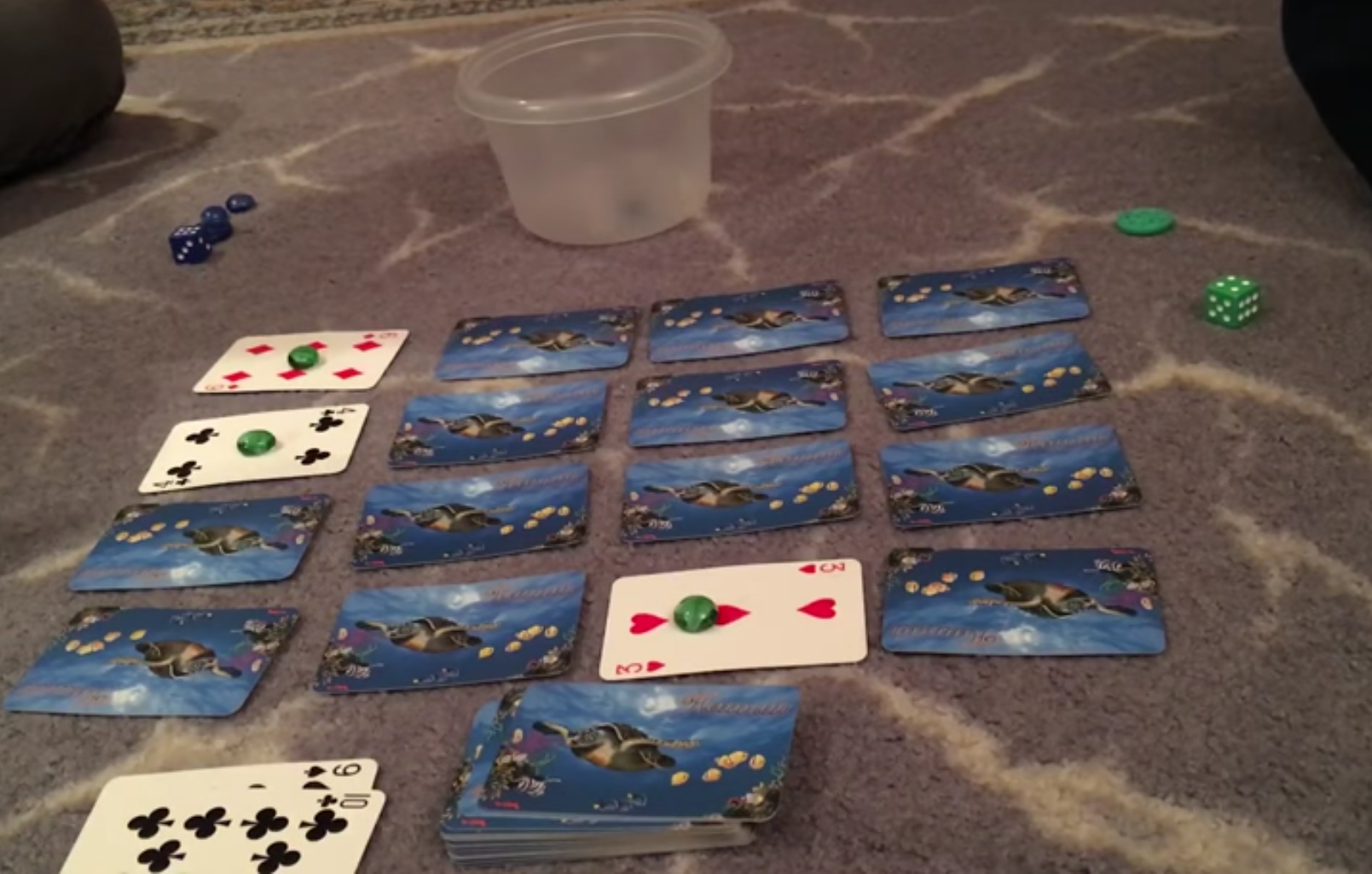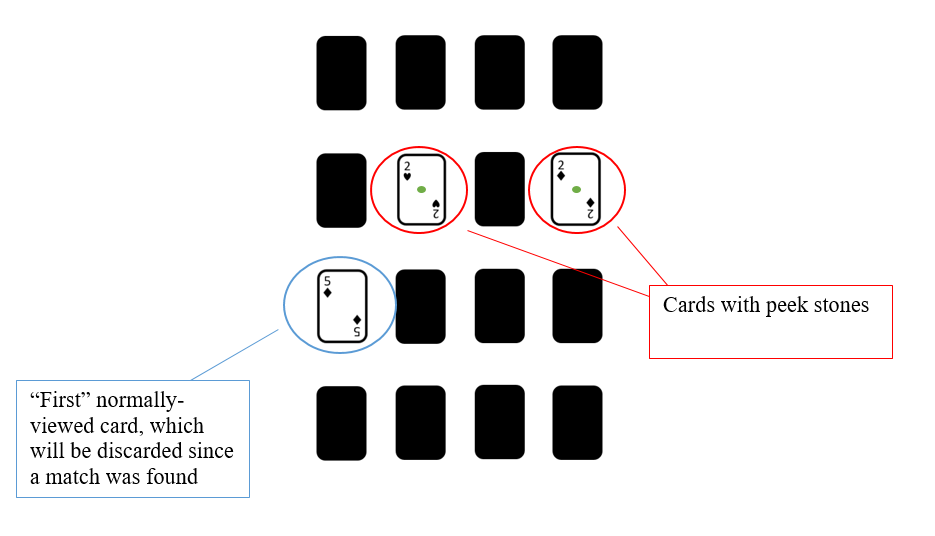Twisted Memory
Introduction to Game Production Midterm Project
Walkthrough Video
Project Premise
The premise of this project was to create a new card game from very limited constraints. I was only allowed to use one deck of cards, plus a small number of baubles or marbles, a couple of coins or tokens, a couple of six-sided dice, and a plastic container at my discretion.
Outcome
Taking the simple game of Memory, I added challenging twists to introduce strategic play and make it fun for adults.

Rulebook
Twisted Memory
Twisted Memory is a two-player game in which players must attempt to match cards by remembering which cards they have already seen, accounting for ones that have been removed. Cards are continually viewed, discarded, and replaced throughout the course of the game. In addition to examining two cards for a match on each turn, players also have special, consumable tokens they can choose to use, which increase the odds of finding a match. Once used, they can try to earn them back by rolling dice at the beginning of each turn.
Number of Players: 2
Average Round Length: 15 minutes
Gameplay Video: Link (https://youtu.be/Z9rXSRg2xWw)
Game Materials:
1 deck of cards (regular deck containing 52 cards)
6 small baubles (3 green, 3 blue)
2 flat tokens (1 green, 1 blue)
2 six-sided dice (1 green, 1 blue)
1 plastic container
Terminology:
Set – Any two cards of the same number (e.g. 2 “Fives,” 2 “Queens,” etc., regardless of color).
Object of the Game:
Players are trying to acquire as many sets as possible. Whoever has more sets at the end of the game, wins.
Gameplay
Set-up:
The dealer shuffles the deck of cards, then deals a 4 x 4 grid of cards face down in between the two players, leaving the remaining cards in a stack next to the grid. Each player takes 3 baubles, 1 token, and 1 die, according to their color (one player has all green pieces, the other has all blue). The person playing against the dealer then takes the first turn.
Normal Turn:
On a turn where no consumable tokens are used, a player starts out simply flipping over any card of the player’s choice in the laid out grid. The player then chooses a second card to flip over as well. If the cards have matching numbers, the player takes the cards and stacks them as a set. After a match, the player gets to go again and view two more cards, continuing the same pattern if another match is found. Otherwise, if the overturned cards do not match, the first card that was viewed gets discarded, and the second card is turned face down again. This protocol applies to any cards turned over after a set is found as well. At the end of a player’s turn, any vacant spots left by matched sets or discarded cards are replenished face down from the stack of cards the dealer placed next to the grid.
Peek Stone
The small, colored baubles are called “peek stones.” A peek stone can be used to reveal an extra card until the end of the player’s turn, and then is consumed. Players can have a maximum of three stones at any one time, and only those of their own color. On a player’s turn, any amount of currently acquired peek stones may be used at any point during the turn, until a final card with no match is viewed. However, they cannot be used retroactively on cards that are already face up. To use a peek stone, the player must pick up a stone and place it immediately on top of a card after flipping the card face up (players must decide to use peek stones before viewing the card they use them on). The card will stay face up with the stone on top until either a match is found for that card, or the turn ends. At that point, the peek stone is consumed and placed in the plastic container, and the card is either taken as a set if found as a match, or flipped face down again if not found as a match. Cards viewed with a peek stone are not counted as the “first” or “second” card viewed, meaning if one of the cards marked with a peek stone matches the second normally-viewed card, the first normally-viewed card is still immediately discarded after the match is found. (For example, if a player starts a turn by marking a card with a peek stone, then the next card turned over normally without a peek stone becomes the “first” card viewed. If the player has another peek stone, the player may choose to use it or save it for another turn. The next card turned over without using a peek stone becomes the “second” viewed card.) When a set is matched, the player gets to go again and any other cards with peek stones persist face up until no matches are found and the turn officially ends. At the end of the turn, all peek stone marked cards are turned face down, the “first” viewed card is discarded, and all matched or discarded cards are replaced with new cards from the stack.

Save Token
The flat tokens are “save tokens” that are used to mark a card a player wants to save, keeping the card face up until a match is found and keeping it from being discarded. Players may only have the single token of their own color. A save token can be played at any time during a player’s turn. In fact, it can actually be played on the first normally-revealed card right before the end of a turn to keep it in play, meaning nothing gets discarded. Save tokens are also played by placing them on the face of a card. The same rules for matches with peek stones apply to save tokens, except that save tokens are only consumed once a match is made, not at the end of a turn. Since save tokens persist through turns, the card saved by the token may create matches for the opposing player during that player’s turn. Once consumed, save tokens also get put in the plastic container.
Replenishing Consumables
To get peek stones and save tokens back, players can roll their own colored die once at the beginning of each turn. Each number on the die represents an action when rolled:
1 or 2: If save token is consumed, the player may take it back from the container. If the save token is currently in play, the player may choose to recall it for later use. The previously saved card is flipped back to face down. Rolling a 1 or 2 does nothing if player has a token but hasn’t played it.
3 or 4: If player has any peek stones in the container, take 1 peek stone from container.
5: Take up to 2 peek stones from container.
6: Take up to 3 peek stones from container.
Note: Players can only draw up to the maximum amount of three stones of their own color. If the player already has three stones and rolls anything from “3” to “6,” no action occurs, if the player has two stones and rolls a “5” or “6,” the player only draws one, and so forth.
End of Game
Once the final cards from the deck are placed in the grid, players continue to play until all the cards are revealed. Once that happens, all cards will be face up and all possible remaining matches have been found, ending the game. Players then count and compare how many sets they each found. The player with the most matched sets wins the game.
Back to top